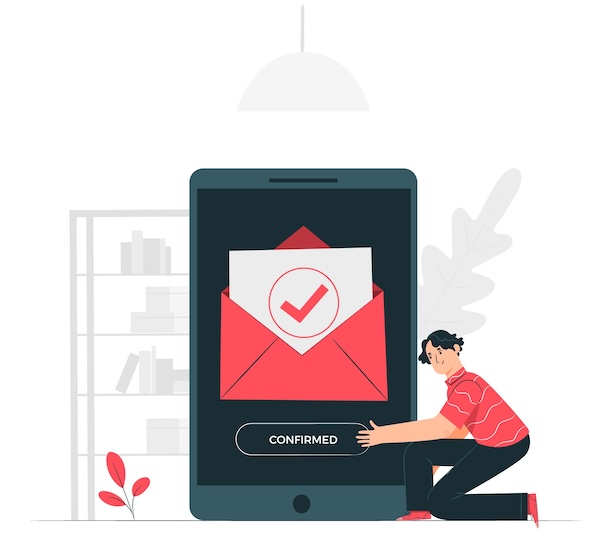So, you’ve just completed various promotional messages for your email marketing campaign. After hitting that send button and expecting multiple replies, some of your emails are returned undelivered. Oops. You forgot to validate the email addresses on your mailing list to see if they are still active.
Emailing an inactive address will cause hard bounces, harming your email deliverability. This guide will give you 4 ways to check if an email address is still valid, tell you why email verification is vital, and provide best practices to keep your mailing list healthy.
Read on to learn more.
4 Effective Ways to Verify Email Addresses
Here are four practical and easy-to-follow methods to check if you have invalid emails on your list:
#1: Check the Email Address Syntax
Essentially, a valid email address has three main parts: a unique identifier (prefix), the “at” (@) sign, and the domain name (e.g., helpful@abc.com). The email prefix must not exceed 64 characters and can consist of letters, numbers from 0 to 9, and special characters. However, the prefix cannot start with a dot, and dots cannot be used consecutively.
Lastly, the domain name will usually contain the name of the email provider or organization. Ensure to check for any misspellings (e.g., @gmial.com, @outloo.com, etc.) and a common top-level domain (.com, .net, or .org) is attached at the end.
#2: Check Emails Using Email Validation API Tools
Suppose you have a signup form on your site for users to subscribe and get exclusive product content. While this email list-building method is effective, you might occasionally get invalid emails from fraudulent users. Interacting with one of those emails will decrease your sender reputation.
One way to prevent this issue is by using an email validation API. It’s an email verification tool that can be integrated directly into your site’s forms, allowing you to check if an email is valid in real-time. A powerful API can also identify a disposable email address (temporary or self-destructing emails) and spam traps and prevent hard bounces.

#3: Do Bulk Email Verification
If you have a growing business, you’ll most likely have various email lists gained from your site or social media platforms. However, using a simple email address checker may be impractical since you have many email lists.
In such cases, you can use bulk verification; it’s an email verification method that you can use to clean your mailing lists. You can upload a CSV file from Google Sheets or another app for batch processing, making the verification process efficient.
Related: Bulk email list verification with InboxAlly
#4: Use a Reputable Email Validation Service
Instead of using platforms for different email verification tools, you can avail of an email verification service. They offer complete verification tools, including email checkers, bulk verification, APIs, and more.
These services automate the entire verification process, including email spell checks and syntax checking, spam trap detection, and email box validation. They also cover domain/MX records (mail exchange records) verification so your emails are routed to the correct mail servers and arrive at the intended recipient.
Note: If you want an effective email deliverability solution with list cleaning and verification features, consider InboxAlly. It offers email validation features and supports large email lists, ensuring that you deliver emails only to active contacts. Register for a free trial now.
Why is Email Verification Necessary?

Ensuring that you have valid addresses on your email list gives several benefits for your email campaign, which include:
- Avoiding spam traps and complaints – Spam traps, or honeypots, are fake email addresses or contacts used by internet service providers (ISPs) and blocklist operators to lure spammers. They can also be legitimate email addresses that are now inactive. Sending an email to one of these traps will damage your sender reputation and get your emails blocked or placed into the spam folder.
As for spam complaints, a robust campaign should only have 5 complaints for every 5,000 emails sent. You can use this free email spam checker to learn more about your email deliverability and spam score.
- Preventing high bounce rates – Sending emails to spam traps or risky addresses will cause them to bounce or be undelivered. Running your email database on an email verification service will prevent this issue. Ideally, a healthy campaign should have a less than 5% bounce rate.
- Reducing the odds of blacklists – Sending emails to spam traps may get your mail server blacklisted by email service providers. Once you’re blocked from an email provider, it prevents your emails from reaching their servers. Some email providers share their blacklists with other clients, which may cause you to get blocked by multiple ESPs.
Overall, it’s crucial to declutter your email database from inactive emails to increase your campaign’s performance and deliverability. It can also improve your brand awareness by reaching more customers, leading to more engagement and conversions.
Additionally, even with a verified email list, you might encounter issues with email deliverability, such as Gmail blocking your emails. Understanding the reasons behind this can help you take corrective measures to ensure your messages reach the intended recipients
Best Practices to Prevent Invalid Emails on Your List
A fraudulent or invalid email account can end up on your list for a few reasons, but it mainly boils down to poor email list management. To solve this issue, here are a few methods to prevent invalid email addresses from entering your mailing list:
Avoid Purchased Email Lists
It goes without saying that you should build your mailing list organically and avoid purchasing email lists. Generally, you shouldn’t include email addresses that haven’t opted into your business’s campaigns. Instead, you can use a double opt-in system on your signup forms—a free method that encourages valid and interested users to be included on your mailing lists.

Check and Segment Your Mailing List
Your list can sometimes be contaminated with honeypots, directly affecting your sender reputation. To avoid this, you can use an email validation API to check if an email address is valid in your signup forms. You can also segment users based on engagement and verify inactive email accounts.
Keep Your List Updated
To keep your list up-to-date, you can send re-engagement email campaigns to contacts who haven’t responded to your message in the last few months. That way, you can weed out inactive contacts and ones who might be disguised as spam traps.
Final Thoughts
If you have a growing business, it entails that you’ll have a large email list, which is a challenge to clean and maintain. You can keep your mailing list consistently healthy and legitimate by avoiding purchased email lists, keeping your list updated, and using email verifier tools.
Besides validating your email lists, monitoring your campaign’s email deliverability is critical. For this, we recommend you try InboxAlly, the ultimate email deliverability tool. It has various features for increasing inbox placement, ensuring your emails reach the primary inbox, and avoiding the dreaded spam folder.
Curious about how InboxAlly can help increase email deliverability and maintain a healthy mailing list for your campaigns? Explore our core features now and say goodbye to high bounce rates today!